 Gold Membership
Gold Membership
R
Occupational Health and Safety Act, 1993 (Act No. 85 of 1993)RegulationsMajor Hazard Installation Regulations, 2022AnnexuresAnnexure A : Dangerous substances to which these Regulations applyChapter 3 : Classification of pipelines as major hazard establishment |
A pipeline is considered an establishment if it contains any of the following:
| (1) | A fluid which— |
| (a) | is flammable in air; |
| (b) | has a boiling point below 5°C at 1 bar absolute; and |
| (c) | is or is to be conveyed in a pipeline as a liquid. |
| (2) | A fluid which is or is to be conveyed in a pipeline as a gas which is— |
| (a) | at pressures at above 8 bar absolute*; |
| (b) | flammable in air**. |
| (3) | Pressurised substances: |
| (a) | Mixtures of gas and liquid which have a vapour pressure in excess of 0,5 bar above atmospheric pressure when in equilibrium with its vapour included; |
| (b) | A liquid which has a vapour pressure greater than 1,5 bar absolute when in equilibrium with its vapour at either the actual temperature of the liquid or at 20°C. |
| (4) | A very toxic fluid which— |
| (a) | at 20°C has a saturated vapour pressure greater than 0,001 bar; or |
| (b) | is or is to be conveyed in the pipeline as a liquid at a pressure greater than 4,5 bar absolute. |
| (5) | A very toxic or toxic fluid which— |
| (a) | is a gas at 20°C and 1 bar absolute; and |
| (b) | is or is to be conveyed as a liquid or a gas, i.e. ammonia. |
| (6) | A toxic fluid which— |
| (a) | at 20°C has a saturated vapour pressure greater than 0,4 bar; and |
| (b) | is or is to be conveyed in the pipeline as a liquid. |
| (7) | An oxidising fluid which is or is to be conveyed as a liquid. |
| (8) | A fluid which reacts violently with water. |
| (9) | Acrylonitrile. |
| (10) | Carbon dioxide. |
| (11) | Gasoline. (Note14) |
| * | Paragraph 2(a) also covers liquefied gases which are flammable in air when they are conveyed as a liquid. This includes butane and propane when conveyed in a pipeline as a liquid. |
| ** | Paragraph 2(b) is applicable to flammable gases conveyed as a gas. In such cases the additional duties only apply when the flammable gas is conveyed at a pressure in excess of 8 bars absolute. This covers such fluids as methane, butane and propane when conveyed as a gas. |
NOTES
| (1) | The quantities set in Chapters 1 and 2 relate to each establishment. |
| (2) | Mixtures and preparations must be treated in the same way as pure substances, provided they remain within the concentration limits set according to their properties under the CLP Regulations (EC 1272\2008, as amended), unless a percentage composition or other description is specifically given. |
| (3) | Ammonium nitrate: fertilisers capable of self-sustaining decomposition. |
This applies to ammonium nitrate-based compound/composite fertilisers (compound or composite fertilisers containing ammonium nitrate with phosphate and/or potash) which are capable of self-sustaining decomposition according to UN Trough Test (Part III, subsection 38.2) and in which the nitrogen content as a result of ammonium nitrate is—
| (a) | between 15,75% and 24,5% by weight and either with not more than 0,4% total combustible or organic materials or which satisfies the requirements of United Nations Recommendations on the Transport of Dangerous Goods: Manual of Tests and Criteria (3rd revised Edition, or as amended from time to time), Ammonium Nitrate Materials (High Nitrogen Content) Safety Regulations 2003,as amended, "the detonation resistance test"; or |
| (b) | 15,75% or less by weight and unrestricted combustible materials. |
| (4) | Ammonium nitrate: fertiliser grade. |
This applies to straight ammonium nitrate-based fertilisers and to ammonium nitratebased compound/composite fertilisers which satisfies the requirements of UN TDG and in which the nitrogen content as a result of ammonium nitrate is—
| (a) | more than 24,5% by weight, except for mixtures of ammonium nitrate with dolomite, limestone and/or calcium carbonate with a purity of at least 90%; |
| (b) | more than 15,75% by weight for mixtures of ammonium nitrate and ammonium sulphate; |
| (c) | more than 28% by weight for mixtures of ammonium nitrate with dolomite, limestone and/or calcium carbonate with a purity of at least 90%, and which satisfy the detonation resistance test. |
| (5) | Ammonium nitrate: technical grade. |
This applies to—
| (a) | ammonium nitrate and preparations of ammonium nitrate in which the nitrogen content as a result of the ammonium nitrate is— |
| (i) | between 24,5% and 28% by weight, and which contain not more than 0,4% combustible substances; or |
| (ii) | more than 28% by weight, and which contain not more than 0,2% combustible substances; |
| (b) | aqueous ammonium nitrate solutions in which the concentration of ammonium nitrate is more than 80% by weight. |
| (6) | Ammonium nitrate (10/50): "off-specs" material not satisfying the detonation test. |
This applies to—
| (a) | material rejected during the manufacturing process and to ammonium nitrate and preparations of ammonium nitrate, straight ammonium nitrate-based fertilisers and ammonium nitrate-based compound/composite fertilisers referred to in Notes 2 and 3, that are being or have been returned from the final user to a manufacturer, temporary storage or reprocessing plant for reworking, recycling or treatment for safe use, because they no longer comply with the specifications of Notes 4 and 5; or |
| (b) | fertilisers which do not fall within Notes 3(a) and 5 because they do not satisfy the detonation resistance test, other than fertilisers which— |
| (i) | at the time of delivery to a final user satisfied the detonation resistance test; but |
| (ii) | later became degraded or contaminated; and |
| (iii) | are temporarily present at the establishment of the final user prior to their return for reworking, recycling or treatment for safe use or to their being applied as fertiliser. |
*15,75% nitrogen content by weight as a result of ammonium nitrate corresponds to 45% ammonium nitrate.
**24,5% nitrogen content by weight as a result of ammonium nitrate corresponds to 70% ammonium nitrate.
***28% nitrogen content by weight as a result of ammonium nitrate corresponds to 80% ammonium nitrate.
| (7) | Potassium nitrate: |
| (a) | Potassium nitrate (5 000/10 000): composite potassium nitrate-based fertilisers composed of potassium nitrate in prilled/granular form. |
| (b) | Potassium nitrate (1 250/5 000): composite potassium nitrate-based fertilisers composed of potassium nitrate in crystalline form. |
| (8) | Polychlorodibenzofurans and polychlorodibenzodioxins. The quantities of polychlorodibenzofurans and polychlorodibenzodioxins are calculated using the following factors: |
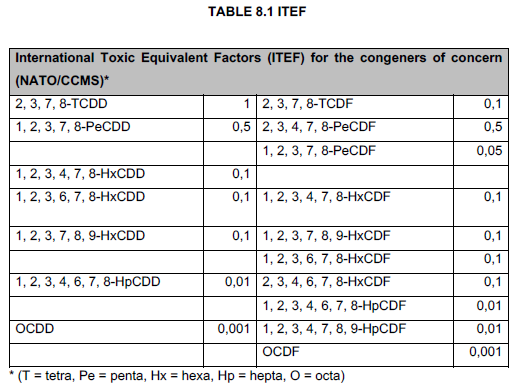
| (9) | In a case where dangerous substances fall within category P5a flammable liquids or P5b flammable liquids, then for the purposes of these Regulations the lowest qualifying quantities apply. |
| (10) | Dangerous substances that fall within the Acute Toxic Category 3 via the oral route (H 301) fall under entry H2 Acute Toxic in those cases where neither acute inhalation toxicity classification nor acute dermal toxicity classification can be derived, for example, due to lack of conclusive inhalation and dermal toxicity data. |
| (11) | Flammable aerosols classified in accordance with the Classification and Labelling of Chemicals (GHS) classification criteria for substances and mixtures, physical hazards, and flammable gases and aerosols. |
| (12) | In order to use paragraph (11), the aerosol dispensers must not contain flammable gas Category 1 or 2 nor flammable liquid Category 1. |
| (13) | In accordance with CLP Regulation, the liquids with a flash point of more than 35°C need not be classified in Category 3 if negative results have been obtained in the sustained combustibility test L.2, Part III, section 32 of the UN Manual of Tests Criteria. This is, however, not valid under elevated conditions such as high temperature or pressure and therefore such liquids are included in this categories. |
| (14) | "Gasoline" means any petroleum derivative, other than liquefied petroleum gas, with a flash point between -51°C and -40°C and which is suitable for use in motor vehicles. |
| (15) | The following examples are for illustrative purposes only and each situation should be considered carefully. In case of any doubt, the individual situation should be discussed with the approved inspection authority. |
| (16) | The substances present at an establishment only in quantities equal to or less than 2% of the relevant qualifying quantity must be ignored for the purposes of calculating the total quantity present if their location within an establishment is such that it cannot act as an initiator of a major incident elsewhere on site. |
| (16.1) | Application of the aggregation of substances |
Example 1
A site with 4 tonnes of hydrogen (medium hazard threshold 5 tonnes) and 1 500 tonnes of flammable liquids meeting Category 6 of Chapter 3 of Annexure A (medium hazard threshold 5 000 tonnes).
The aggregation rule gives: (4/5) + (1 500/5 000) = 0,8 + 0,3 = 1,1
As this result is greater than 1, medium hazard category applies.
Example 2
A site with 150 tonnes of toxic substances meeting Category 2 of Chapter 2 of Annexure A (high hazard threshold 200 tonnes) and 1 tonne of arsenic pentoxide (high hazard threshold 2 tonnes).
The aggregation rule gives: (150/200) + (1/2) = 0,75 + 0,5 = 1,25
As this result is greater than 1, high hazard category applies.
| (17) | In the case of an establishment where no individual substance or preparation is present in a quantity above or equal to the relevant qualifying quantities, the following rules must be applied to determine if the establishment is covered by the relevant requirements of these Regulations: |
| (17.1) | Application of the aggregation of categories |
| 1. | High Hazard Category: |
If the sum - q1/QU1 + q2/QU2 + q3/QU3 + q4/QU4 + q5/QU5 + … is greater than or equal to 1, where—
| (a) | qx = the quantity of dangerous substance x (or category of dangerous substances) falling within Chapter 1 or 2; and |
| (b) | QUX = the relevant qualifying quantity for substance or category x from column 5 of Chapter 1 or 2, then these Regulations shall apply. |
| 2. | Medium Hazard Category: |
If the sum - q1/QM1 + q2/QM2 + q3/QM3 + q4/QM4 + q5/QM5 + … is greater than or equal to 1, where—
| (a) | qx = the quantity of dangerous substance x (or category of dangerous substances) falling within Chapter 1 or 2; and |
| (b) | QMX = the relevant qualifying quantity for substance or category x from column 4 of Chapter 1 or 2, then these Regulations shall apply. |
| 3. | Low Hazard Category: |
If the sum - q1/QL1 + q2/QL2 + q3/QL3 + q4/QL4 + q5/QL5 + … is greater than or equal to 1, where—
| (c) | qx = the quantity of dangerous substance x (or category of dangerous substances) falling within Chapter 1 or 2; and |
| (d) | QLX = the relevant qualifying quantity for substance or category x from column 3 of Chapter 1 or 2, then these Regulations shall apply. |
| (18) | These rules must be used to assess the overall hazards associated with toxicity, flammability and eco-toxicity. They must therefore be applied three times— |
| (a) | for the addition of substances and preparations named in Annexure A and classified as toxic or very toxic, together with substances and preparations falling into Category 1 or 2 in Chapter 2; |
| (b) | for the addition of substances and preparations named in Annexure A and classified as oxidising, explosive, flammable, highly flammable or extremely flammable, together with substances and preparations falling into Category 3, 6, 7a, 7b or 8 of Chapter 2; and |
| (c) | for the addition of substances and preparations named in Annexure A1 and classified as Annexure A for the environment (toxic to aquatic organisms), together with substances and preparations falling into Category 7(a) or 9(b) in Chapter 2, and the relevant provisions of these Regulations shall apply if any of the sums thereby obtained is greater than or equal to 1. |
The relevant provisions of these Regulations apply where any of the sums obtained by (a), (b) or (c) is greater than or equal to 1, stated in material safety data sheets of substances as per Dangerous Substances Directive (67/548/EEC).
| (18.1) | Application of the 2% rule |
The 2% rule should be applied as follows:
| 1. | The substances present at an establishment only in quantities equal to or less than 2% of the relevant qualifying quantity must be ignored for the purposes of calculating the total quantity present if their location within an establishment is such that it cannot act as an initiator of a major incident elsewhere on site. |
| 2. | This allows for some quantities of substances to be ignored when deciding whether the Regulations apply. Individual quantities of dangerous substances can be ignored if they fulfil the following criteria: |
| (a) | the quantity is 2% or less of its threshold quantity; and |
| (b) | its location means that it cannot start a major incident elsewhere on site. |
| 3. | Note that– |
| (a) | both criteria must be met; |
| (b) | the quantity involved may be capable of producing a major incident by itself; |
| (c) | it may be capable of starting a major incident off site; and |
| (d) | if it meets the criteria, it can be ignored only when determining whether the establishment is within the scope of these Regulations. If the establishment is subject to the Regulations because of the presence of other dangerous substances, any quantity of 2% or less must be taken into account when considering the sources and consequences of major incidents. |
The diagram below does not depict an approved installation but it is meant for illustrative purposes only.
Example 1
An establishment with—
| (a) | a large tank containing 49,5 tonnes of LPG; and |
| (b) | a small tank containing 1,0 tonne of LPG. |
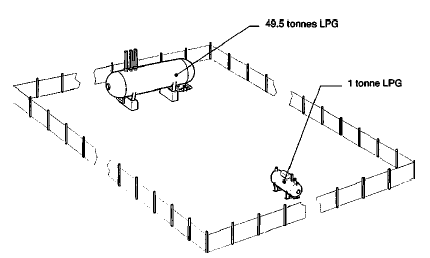
The small tank = 2% of medium hazard threshold (50 tonnes), but the separation from the large tank is sufficient to prevent the small tank starting a major incident at the large tank. It can therefore be ignored in terms of the 2% rule.
The result is that medium hazard category does not apply, even though the total quantity of 50,5 tonnes is above the medium hazard threshold, which places it in the low hazard category.
Example 2
An establishment with—
| (a) | a large tank containing 49,5 tonnes of LPG; and |
| (b) | two small tanks each containing 1,0 tonne of LPG. |
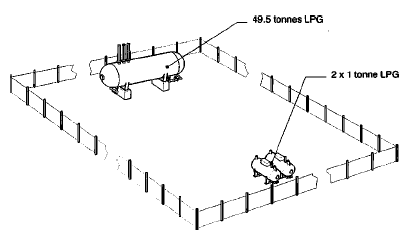
Each small tank = 2% of medium hazard threshold (50 tonnes), but their separation from the large tank and from each other is sufficient to prevent either of them starting a major incident at the other small tank or the large tank. Therefore, each can be ignored in terms of the 2% rule.
The result is that medium hazard category does not apply, even though the total quantity of 51,5 tonnes is above the medium hazard threshold, which places it in the low hazard category.
Example 3
An establishment with—
| (a) | a large tank containing 49,5 tonnes of LPG; and |
| (b) | two small tanks each containing 1,0 tonne of LPG. |
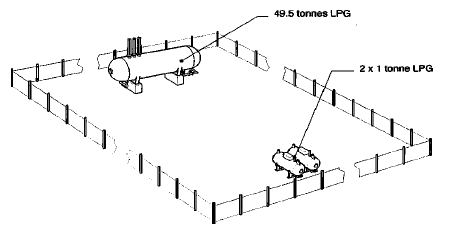
The small tanks are adjacent to each other but their separation from the large tank is not sufficient to prevent the small tanks starting a major incident at the large tank.
Both small tanks = 2% of threshold (50 tonnes), but as they are adjacent they should be regarded as one quantity of more than 2%; therefore, the 2% rule does not apply. As the total quantity of 51,5 tonnes exceeds the medium hazard threshold, the medium hazard threshold applies to this establishment.
Example 4
An establishment with—
| (a) | a large tank containing 49,5 tonnes of LPG; and |
| (b) | two small tanks each containing 0,5 tonnes of LPG. |
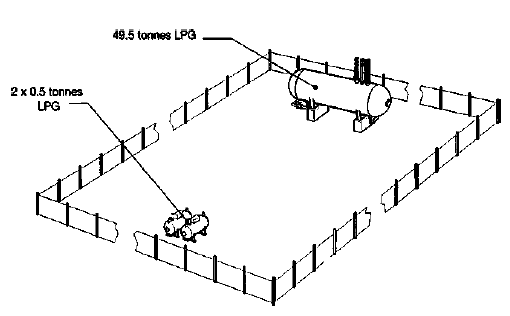
The small tanks are adjacent to each other but well separated from the large tank.
Both small tanks = 1% of threshold (50 tonnes), but as they are adjacent they should be regarded as one quantity of 1 tonne which = 2%. As this cannot start a major incident elsewhere on site, the 2% rule applies and the medium hazard category does not apply even though the total quantity is greater than the medium hazard threshold, which places it in the low hazard category.
Example 5
An establishment with—
| (a) | a large tank containing 49,5 tonnes of LPG; and |
| (b) | a compound containing 100 x 10 kg cylinders of LPG, i.e. 1 tonne in total. |
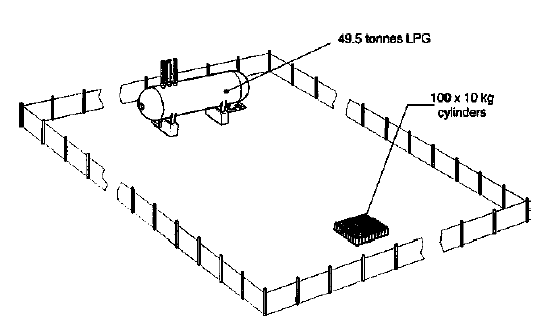
The separation between the compound and the large tank is sufficient to prevent the cylinders starting a major incident at the large tank.
Each cylinder contains less than 2% of the medium hazard threshold (50 tonnes) and the total quantity in the cylinders is 1 tonne, which is 2% of the medium hazard threshold. The cylinder compound cannot start a major incident elsewhere on site, so the 2% rule applies. Therefore, the medium hazard category does not apply, which places it in the low hazard category.
Example 6
An establishment with—
| (a) | a large tank containing 49,5 tonnes of LPG; and |
| (b) | a compound containing 100 x 15 kg cylinders of LPG, i.e. 1,5 tonnes in total. |
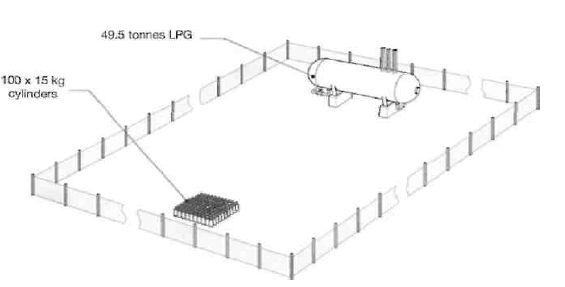
The separation between the compound and the large tank is sufficient to prevent the cylinders starting a major incident at the large tank.
Each cylinder contains less than 2% of the medium hazard threshold (50 tonnes) but as they are adjacent to each other they should be treated as one quantity of 1,5 tonnes, which is greater than 2% of the medium hazard threshold. Therefore, the medium hazard category applies to this establishment.
Example 7
An establishment with—
| (a) | a large tank containing 49,5 tonnes of LPG; |
| (b) | a tank containing 0,9 tonnes of highly flammable liquid (medium hazard threshold 50 tonnes); and |
| (c) | a tank containing 0,1 tonnes of extremely flammable liquid (medium hazard threshold 10 tonnes). |
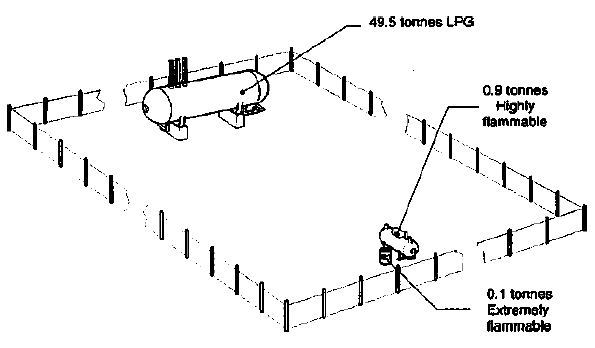
The small tanks are adjacent, but their separation from the large tank is enough to prevent the small tanks starting a major incident at the large tank. The total quantity for application purposes is determined by the aggregation rules, but first it is necessary to determine if the small tanks together exceed 2% of their threshold.
To do this, each one is expressed as a percentage of its own threshold and added together:
| 1. | Small tanks |
(0,9/50) + (0,1/10) = 0,018 + 0,01 = 1,8% + 1,0% = 2,8%. As this is greater than 2%, they cannot be ignored for application purposes.
The aggregation rule gives:
(49,5/50) + (0,9/50) + (0,1/10)
= 0,99 + 0,018 + 0,01
= 1,018
1,018 is greater than 1, so the medium hazard category applies to the establishment.
Example 8
An establishment with—
| (a) | a large tank containing 49,5 tonnes of LPG; |
| (b) | a tank containing 0,9 tonnes of highly flammable liquid (medium hazard threshold 50 tonnes); and |
| (c) | a tank containing 0,1 tonnes of extremely flammable liquid (medium hazard threshold 10 tonnes). |
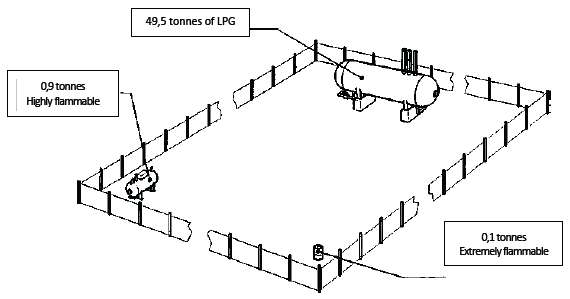
The separation is sufficient that neither small tank can start a major incident at either the other small tank or the large tank.
Because neither small tank exceeds 2% of its threshold, they can both be ignored for application purposes and the total quantity for application purposes is, therefore, the 49,5 tonnes of LPG. This is below its medium hazard threshold, so the medium hazard category does not apply to the establishment, which places it in the low hazard category.